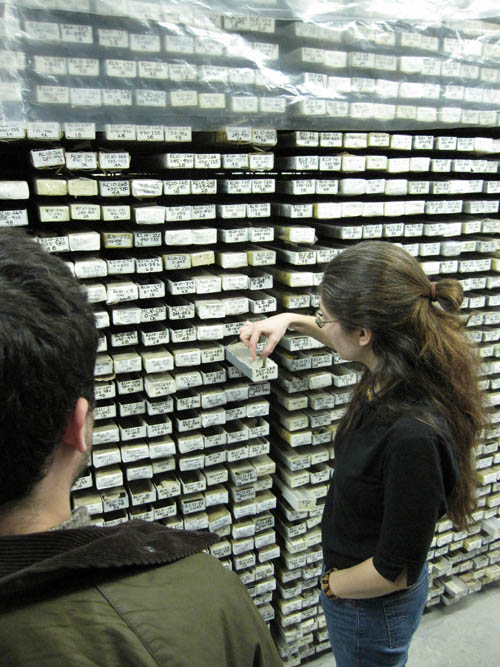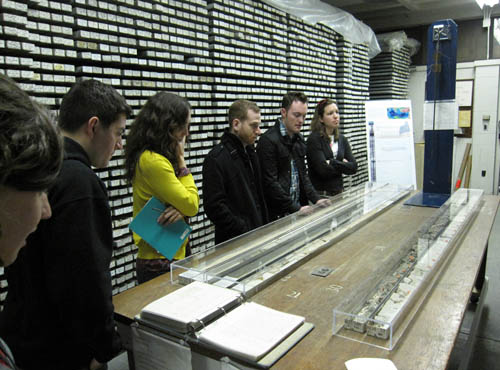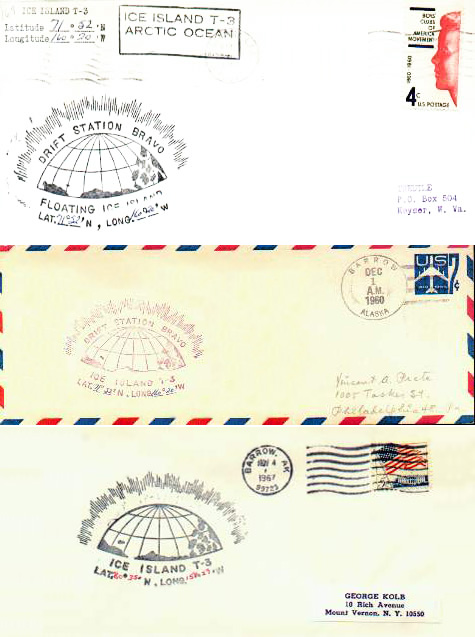Drift Station Bravo
The other day I took my students up to the Lamont-Doherty Earth Observatory for an afternoon of tours through the awe-inspiring Core Lab and for a visit with the Borehole Group; we stopped in at the Lamont-Doherty seismic research station along the way, where we watched our technician-guide create artificial earthquakes with a wooden mallet so that we could watch his digital equipment go to work. It was a great day.





 [Images: Inside the Core Lab at Columbia's Lamont-Doherty Earth Observatory].
[Images: Inside the Core Lab at Columbia's Lamont-Doherty Earth Observatory].
While we were in the Core Lab, however (photographs of which you see above), our guide mentioned that many of the older core samples—where a coring device is dropped all the way to the seabed in order to take a large cylindrical sample of geological material back to the surface for archiving and analysis—were taken not from ships but from icebergs.
These mobile islands of ice would be temporarily repurposed, turned into science labs at sea. Researchers would simply ride them till they melted, often quite far south into the waters of the North Atlantic.
I had forgotten about this. Oddly, I have been meaning to post about an old ice island called Drift Station Bravo, used for exactly these sorts of purposes, since the earliest days of BLDGBLOG (in fact, I mentioned Drift Station Bravo in a very old interview with Ballardian).
In light of the Glacier/Island/Storm studio, then, and after our inspiring tour of Lamont-Doherty, I thought I'd briefly recount this awesome story.
 [Image: Drift Station Bravo postage cancellation mark, via Polar Philately].
[Image: Drift Station Bravo postage cancellation mark, via Polar Philately].
As explained by the Polar Philately page, Colonel Joseph O. Fletcher, commander of an Air Force weather squadron stationed in the Arctic, discovered "a large tabular iceberg... that had broken off the Arctic ice shelf... [and] gone adrift."
This island of solid ice was soon "codenamed T-1, taken from its original radar designation as a target." Future "ice islands" were codenamed T-2 and T-3.
 [Image: Letters postmarked from Drift Station Bravo, via Polar Philately].
[Image: Letters postmarked from Drift Station Bravo, via Polar Philately].
Again, from the Polar Philately website:
 [Image: A postal marking from Drift Station Bravo, via Polar Philately].
[Image: A postal marking from Drift Station Bravo, via Polar Philately].
Over on InfraNet Lab, we read that ice "has been a strategic building material in the Arctic for the construction of roads, airstrips, housing, and, in the last few decades, as temporary drilling platforms to explore for oil."
Given this act of territorial appropriation, and bearing in mind the island's fundamental state of mobility, what are the implications for its maritime jurisdiction, as Enrique Ramirez explores over on a456?
 [Image: A letter from Drift Station Bravo, via Polar Philately].
[Image: A letter from Drift Station Bravo, via Polar Philately].
This becomes a question of immediate geopolitical concern when we consider the fact that Drift Station Bravo and its ilk were actually created in a Sputnik-like reaction to the Soviet's own very active ice island program. The Soviets "already operated six drifting ice camps of this kind," we read in a documentary transcript, downloadable as a 27kb PDF, but, "owing to the particular strategic importance and sensitivity of the Arctic Basin, little information from these early Soviet stations had reached the West."
That same transcript goes on to explain exactly how the U.S managed to architecturally colonize these nomadic ice worlds. Like a vision straight out of Archigram, military civilization on the ice established itself as follows:
The story expands rapidly from here. In an article originally published in the September-October 1966 issue of Air University Review, we read that competitive Soviet drift stations apparently discovered a "second magnetic north pole... located near 80° N and 178° W, with magnetic medians extending across the Arctic Ocean," and that sulfuric gas fumes from a badly timed undersea volcanic eruption killed at least one unlucky crew member.
The whole thing amazes me, in fact. I don't know why I've been sitting on this story for so long, but it's nice, finally, to put something up about Drift Station Bravo. How many other icebergs actually had their own postal codes?
(I owe a huge thanks to the Lamont-Doherty Earth Observatory staff for taking my students around their facilities—we had a great time. Thanks!)





 [Images: Inside the Core Lab at Columbia's Lamont-Doherty Earth Observatory].
[Images: Inside the Core Lab at Columbia's Lamont-Doherty Earth Observatory].While we were in the Core Lab, however (photographs of which you see above), our guide mentioned that many of the older core samples—where a coring device is dropped all the way to the seabed in order to take a large cylindrical sample of geological material back to the surface for archiving and analysis—were taken not from ships but from icebergs.
These mobile islands of ice would be temporarily repurposed, turned into science labs at sea. Researchers would simply ride them till they melted, often quite far south into the waters of the North Atlantic.
I had forgotten about this. Oddly, I have been meaning to post about an old ice island called Drift Station Bravo, used for exactly these sorts of purposes, since the earliest days of BLDGBLOG (in fact, I mentioned Drift Station Bravo in a very old interview with Ballardian).
In light of the Glacier/Island/Storm studio, then, and after our inspiring tour of Lamont-Doherty, I thought I'd briefly recount this awesome story.
 [Image: Drift Station Bravo postage cancellation mark, via Polar Philately].
[Image: Drift Station Bravo postage cancellation mark, via Polar Philately].As explained by the Polar Philately page, Colonel Joseph O. Fletcher, commander of an Air Force weather squadron stationed in the Arctic, discovered "a large tabular iceberg... that had broken off the Arctic ice shelf... [and] gone adrift."
This island of solid ice was soon "codenamed T-1, taken from its original radar designation as a target." Future "ice islands" were codenamed T-2 and T-3.
- On March 19, 1952, the U.S. Air Force led by Colonel Fletcher and some scientists landed on this ice island [T-3] in a C-47 aircraft, setting up a weather observation station. Fletcher established a research station that was manned at this big ice sheet for roughly the next 25 years, despite a grim quote given by the head of the Alaska Air Command at the time, a General Old, who was quoted in a Life magazine article of the time as saying "I don't see how any man can live on this thing."
- Fletcher's Ice Island, and the research station that was located on it, rotated in circles in the Arctic Ocean, floating aimlessly along in the Arctic currents in a clockwise direction. The station was inhabited mainly by scientists along with a few military crewmen and was resupplied during its existence primarily by military planes operating from Barrow, Alaska.
 [Image: Letters postmarked from Drift Station Bravo, via Polar Philately].
[Image: Letters postmarked from Drift Station Bravo, via Polar Philately].Again, from the Polar Philately website:
- During the period of active habitation, T-3 covers [basically postage stamps] were serviced, each stamped with a variety of hand-stamped cachets and markings, dated, and often marked with a manuscript notation of the geographic position of the drifting station on that particular day of ops. The T-3/Bravo covers were often cancelled at Barrow or at a USAF base in Alaska, and then placed in the mailstream.
 [Image: A postal marking from Drift Station Bravo, via Polar Philately].
[Image: A postal marking from Drift Station Bravo, via Polar Philately].Over on InfraNet Lab, we read that ice "has been a strategic building material in the Arctic for the construction of roads, airstrips, housing, and, in the last few decades, as temporary drilling platforms to explore for oil."
- Ice islands are formed by spraying ice into cold air (below 20 degrees F), and layering the ice until it reaches a thickened state. These islands are either grounded at the bottom of the sea floor or are floating structures in deeper waters. Fabricated in just two months, these islands provide enough stability to support exploratory drilling tools including the rig and attendant equipment.
Given this act of territorial appropriation, and bearing in mind the island's fundamental state of mobility, what are the implications for its maritime jurisdiction, as Enrique Ramirez explores over on a456?
 [Image: A letter from Drift Station Bravo, via Polar Philately].
[Image: A letter from Drift Station Bravo, via Polar Philately].This becomes a question of immediate geopolitical concern when we consider the fact that Drift Station Bravo and its ilk were actually created in a Sputnik-like reaction to the Soviet's own very active ice island program. The Soviets "already operated six drifting ice camps of this kind," we read in a documentary transcript, downloadable as a 27kb PDF, but, "owing to the particular strategic importance and sensitivity of the Arctic Basin, little information from these early Soviet stations had reached the West."
That same transcript goes on to explain exactly how the U.S managed to architecturally colonize these nomadic ice worlds. Like a vision straight out of Archigram, military civilization on the ice established itself as follows:
- ...a ski-equipped C-47 landed on the ice and deployed the first team of workers. It included an Air Force Major as camp commander and several soldiers with technical skills who had volunteered for 6 months duty on the ice, plus four of the typical tough and versatile Alaskan construction workers.
Modular buildings, called Jamesway huts, camp supplies, fuels, two small World War II Studebaker tractors, called Weasel, and a small bulldozer, were dropped by parachutes.
The story expands rapidly from here. In an article originally published in the September-October 1966 issue of Air University Review, we read that competitive Soviet drift stations apparently discovered a "second magnetic north pole... located near 80° N and 178° W, with magnetic medians extending across the Arctic Ocean," and that sulfuric gas fumes from a badly timed undersea volcanic eruption killed at least one unlucky crew member.
The whole thing amazes me, in fact. I don't know why I've been sitting on this story for so long, but it's nice, finally, to put something up about Drift Station Bravo. How many other icebergs actually had their own postal codes?
(I owe a huge thanks to the Lamont-Doherty Earth Observatory staff for taking my students around their facilities—we had a great time. Thanks!)





Comments are moderated.
If it's not spam, it will appear here shortly!
Fascinating story, I'll be looking forward to read the pdf. Great blog.
This is a fantastic story. BLDGBLOG has been really excellent for the past week or so. I really liked the two about Van Gogh.
Post a Comment